Page 1: the Pond Damsel family
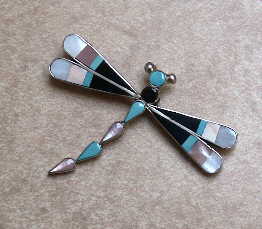
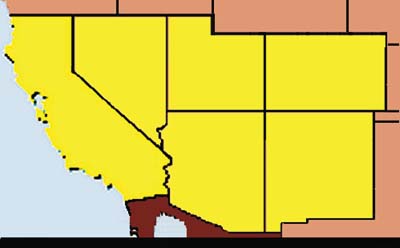
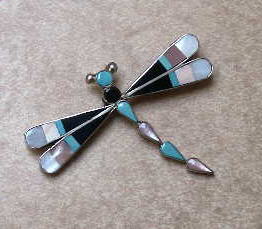
Damselflies (Zygoptera) of the Southwest
Page 1: the Pond Damsel family



|
Updated May 2019 Dragonflies of California and the Greater Southwest, A Beginner's Guide by Kathy Biggs 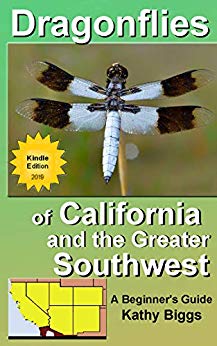
by Kathy Biggs - Price $7.99 Buy through Amazon.com (Kindle app) (includes damselflies) |
... |
Dragonflies of North America, A Color and Learn Book with Activities Kathy Biggs and Tim Manolis (Does contain damselflies) Click to 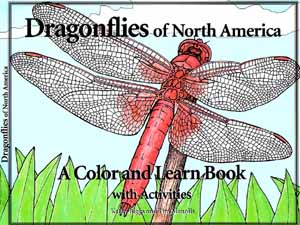
see more information about the book. Published June 2021 For children, grandchildren & your inner child! |
Enter the on-line guide below
Click on image/word to be taken to that kind of Damselfly
This site is 100% privately maintained. If you've found it helpful, a donation to help keep in on the web would be appreciated, thanks! K. Biggs
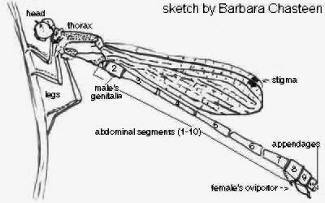
Sketch of a damselfly showing the body parts by Barbara Chasteen |
DAMSELFLIES - ZygopteraSlender-bodied, generally smaller and more frail than dragonflies. Most have an eyespot in back of each eye. When perched, all four wings are usually held together alongside or sail-like over the abdomen. Eyes set far apart on head, appear hammer headed. Weak fliers, usually found not too far from water. Males have a bump (genitalia) under their 2nd abdominal segment and four terminal abdominal appendages. Females have a wide ovipositor on the underside at the end of their abdomen and only two terminal abdominal appendages. Damselflies lay their eggs directly into vegetation. As of 2024, the southwest has at least 84 damselfly species in 17 SW genera, representing all 4 American families. Note that the family Protoneuridae is gone; it has been lumped into the Pond Damsels/Coenagrionidae. http://www.odonatacentral.org/docs/NA_Odonata_Checklist.pdf 1. Pond Damsels - Coenagrionidae - this page 1 2. Shadowdamsels - Platysticidae - on page 2 3. Spreadwings - Lestidae - on page 2 4. Broad-winged Damsels - Calopterygidae - on page 2 |
Directions: Click on the image that looks the most like the damselfly you want to learn more about, or just scroll
down the page for the pond damsels, which are the most common.
Damselflies are arranged within family by predominant color within genus. There are 2 pages of damselfly images.
Pond Damsels continue on this page. Damselflies in the other families are on a second page.
Use your back button to return to this page
Page 1
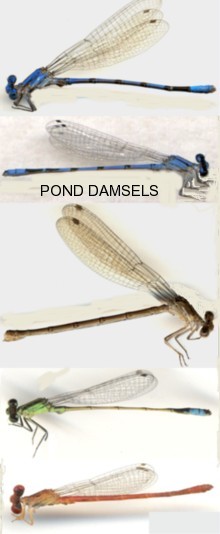
Pond Damsels (Coenagrionidae) 66 species as of 2024 |
This goes to Page 2
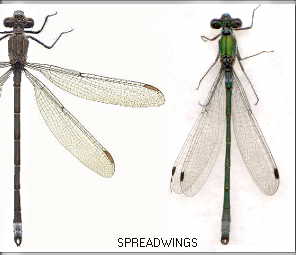
Spreadwings (Lestidae) This link takes you to a new (2nd) page 12 species as of 2024 |
This goes to Page 2
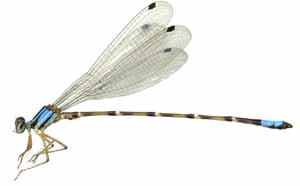
Shadowdamsels (Platysticidae) This link takes you to a new (2nd) page Only one species as of 2024 |
This goes to Page 2
. 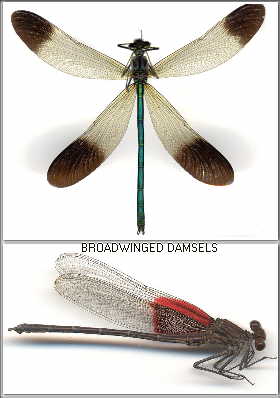
Broadwinged Damsels (Calopterygidae) This link takes you to a new (2nd) page 5 species |

|
Pond Damsels: Coenagrionidaesizes: small to medium; lengths: 20 - 50 mm males: usually blue and black, a few red, yellow or violet; varying degrees of light and dark colors on abdomens; clear wings held alongside or over the abdomen when perched, small stigmas females: abdomen more cylindrical; most tan but some blue or grey/brown or peachy habitats: quite variable, but usually still waters or quiet streams behaviors: wings held closed when perched; low flying 10 SW genera, totaling 66 species: 1. American Bluets, Enallagma: most are blue & black patterned; perch on vegetation; wings at rest are held alongside abdomen; tandem oviposit at still water sites 2. Eurasian Bluets, Coenagrion: similar to American Bluets, showing more black 3. Dancers, Argia: most are blue & black patterned, some are lavender & black, "dancing" flight; perch on ground and/or rocks with wings held closed above abdomen; tandem oviposit in moving waters; territorial wing clapping; long spines on legs 4. Painted Damsel, Hesperagrion: one species; red eyespots & 'tail' 5. Black & White Damsel, Apanisagrion: thin, long abdomen; coloring dark and pale; dense venation on lower margins of wings 6. Red Damsels, Amphiagrion: mostly red abdomen with black thorax; small but stocky 7. Firetails, Telebasis: red coloring; small & petite 8. Exclamation Damsel, Zoniagrion: one species; similar to forktails; 2 blue exclamation-like marks top of thorax 9. Forktails, Ischnura: mostly black; blue on thorax & near abdomen tip; perch on emergent vegetation; nontandem oviposit into floating vegetation; resting wing position variable 10.Sprites, Nehalennia: metallic green coloration; small & petite 11.Slender Threadtails, Protoneura: one SW species; long narrow abdomen Southwestern distribution maps are updated at least annually and are based on Western maps originally created by Dennis Paulson (pre-2007) |

Photo by Bob Claypole Bluets are arranged by similarity in markings. photo of a Bluet swarm Bluet vs Dancer wing position female Bluet - non-malelike color form female Bluet - malelike color form |
GENUS: Enallagma The American Bluets - 17 SW species
description: males are usually bright blue & black patterned; but a few in other states show yellow/orange;
|
| Photos
multiple images - AZ male - CA pair - CA multiple images - CA appendage close-up - CA male - CO male - NV male - NV male - NM female - NM Scans male - CA male - CA male - CA male - CA male - CA male - CA male - CA male - CA male - CA |
Northern Bluet Enallagma annexum (formerly E. cyathigerum)
size: medium, length 29 - 40 mm male: third segment more than 50% blue; side stripe is undivided with a jag near the front; large blue eyespots; lower appendages longer than uppers. Identify to species by appendage shape using hand lens; a coastal NW form is darker than elsewhere female: much less blue, or tan and black similar species: nearly identical to Boreal Bluet; use appendage shape to differentiate habitat: cool still or slow water SW flight period: February 6 - December 1 SW distribution: all SW Southwestern distribution map Information on California Odonata website |
| Photos
male - AZ male - AZ multiple images - AZ male - CA males - CA males - CA multiple images - CA multiple images - CA female - CA female - CA pair - CA pair - CA pair - CA male - NV multiple images male - UT multiple images male - UT Scans male - CA male - CA male - CA male - CA male - UT |
Boreal Bluet Enallagma boreale
size: medium, length 29 - 40 mm male: third segment more than 50% blue; side stripe is undivided with a jag near the front; large blue eyespots; lower appendages longer than uppers. Identify to species by appendages shape using hand lens, see p.98 Com. Drag. Of SW female: much less blue, or tan and black similar species: nearly identical to Northern Bluet; use appendage shape to differentiate habitat: cool still or slow water SW flight period: February 2- October 7 SW distribution: all SW Southwestern distribution map Information on California Odonata website |
| Photos
male - CA male - CA male - CA multiple images - CA multiple images - CA pair - CA male - CO male - CO male - CO female - CO female - CO male - NM male - NM male - NV multiple images male - UT multiple images male - UT Scans male - CA male - CA male - CA female - CA male - CA |
Alkali Bluet Enallagma clausum
size: medium, length 29 - 40 mm male: third segment more than 50% blue; side stripe is undivided with a jag near the front; large blue eyespots; lower appendages only a little longer than uppers. Alkali has thin side stripe; found alkali water. Identify by appendages shape using hand lens, see p.98 Com. Drag. Of the SW female: much less blue, or tan and black habitat: alkaline ponds and lakes SW flight period: May 11 - October 1 SW distribution: all SW but AZ Southwestern distribution map Information on California Odonata website |
| Photos
info - north east multiple images -MN male - MA male - MT male - WI male - MD female - MT Scans male - female - |
Hagen's Bluet Enallagma hageni
size: small, length 26 - 33 mm; in-hand ID required for males and females male: segments 3-8 more blue than black; 3rd segment more than 50% blue; segments 8 & 9 blue; thorax top stripe dark; upper appendages narrow with slightly upturned tip female: pale areas blue or tan; no blue on tail; raised edge of mesogtigmal plates habitat: marshy lakes, ponds, slow streams SW flight period: ~April - ~September SW distribution: CO Southwestern distribution map |
| Photos
multiple images & info males - MT male - MA multiple images - MN pair in wheel - MA male - ID multiple images multiple images female- Mass. Scans male female |
Marsh Bluet Enallagma ebrium
size: small, length 20 - 34 mm; in-hand ID necessary male: small tear-shaped eyespots; segments 3-8 more blue than black; 3rd segment more than 50% blue; segments 8 & 9 blue; thorax top stripe dark; distinctly forked upper appendages with the forks of about equal length female: pale areas blue, green or tan; no blue on tail habitat: vegetated lakeshores, ponds, marshes SW flight period: June 26 - August 24 SW distribution UT Southwestern distribution map |
| Photos
male - AZ multiple images - AZ multiple images - AZ pair - AZ male - CA multiple images - CA female - CA pair - CA multiple images - CA males & females - CA male - CO male - CO male - NV male - NM multiple images cold male - UT multiple images - UT Scans male - AZ male - AZ male - CA male - CA male - CA pair - CA pair - CA male - NM |
Familiar Bluet Enallagma civile
size: medium, length 28 - 39 mm male: markings more blue than black, third segment more than 50% blue; top thorax stripe dark; small comma-shaped eyespots; top appendages longer than lowers, large and finlike with pale "button," appear splayed; see appendage illustrations, p.98 CDSW. Bluets fly low over water along shoreline. female: like male or tan and black similar species: Arroyo Bluet has 3rd seg. more black than blue and forked upper appendages, Tule Bluet has 3rd seg. more black and a smaller pale 'button' on upper appendages; comparison website habitat: still waters with fields SW flight period: all year in south SW distribution: all Southwest Southwestern distribution map Information on California Odonata website |
| Photos
males - CA male - CA male - CA female - CA female - CA female - CA pairs+ - CA multiple images - CA male - CO male - NV male - NV multiple images male - UT Scans male - CA male - CA male - CA |
River Bluet Enallagma anna
size: medium, length 29 - 36 mm male: middle abdominal segments about half-blue from above; appendages slightly forked; uppers noticeably longer than lowers, with the top fork extending well beyond lower appendages and angled downward (without a pale button on end) - noticeable to the naked eye female: pale areas blue or tan habitat: slow streams, ditches SW flight period: April 16 - October 16 SW distribution: all SW but rare in AZ & NM Southwestern distribution map Information on California Odonata website |
| Photos
male - AZ male - AZ multiple images - AZ female - AZ male - CA male - CA male - CA male - CA male - CA male - MX male - MX male - MX male - MX male - MX Scans male - MX female |
Baja Bluet Enallagma eiseni NEW TO USA
size: medium, length 27 - 34 mm male: distinctive - middle abdominal segments about equally blue and dark from above; dark on abdominal segments forms spears which point towards the tail (other bluets' dark areas point towards head); segments 8 - 10 blue; large blue eyespots have a connecting blue line; upper appendages noticeably longer than lowers, noticeable to the naked eye; from above have inward facing 'hooks;' lower appendages held next to abdomen, appear to be 'missing' female: pale areas blue or tan, of ten with greenish cast; patterning similar to male's habitat: slow streams, pools of desert oases SW flight period: March 28 - December SW distribution: VERY RARE; AZ, CA - report & document all sightings Southwestern distribution map Information on California Odonata website |
| Photos
male - AZ multiple images- AZ multiple images - AZ male - CA male - CA multiple images - CA multiple images - CA female - CA female - CA male - CO male - NM male - NM male - NV male in flight - NV multiple images male - UT multiple images young male - UT multiple images female - UT Scans male - CA male - CA male - CA male - CA male - CA male - CA pair - CA |
Tule Bluet Enallagma carunculatum
size: small/medium, length 26 - 37 mm male: segments 3-7 more black than blue; 3rd segment more than 50% black; segments 8 & 9 blue; thorax top stripe wide & dark; large pale "button" tip of upper appendages. illustrations of Bluet appendages. female: pale areas blue or tan; no blue on tail similar species: Arroyo Bluet has forked upper appendages, Familiar Bluet has 3rd segment more blue; comparison website habitat: lakes, ponds, streams; especially with tules SW flight period: all year in its southern range SW distribution: all Southwest Southwestern distribution map Information on California Odonata website |
| Photos
male - AZ male - AZ male - AZ male - AZ male - AZ multiple images - AZ multiple images - AZ multiple images - AZ female - AZ male - CA male - CA male - CO male - NM male - NM male - NM male - NM male - NM pair - NM male - NV male - NV multiple images male - UT Scans male - CA female - CA |
Arroyo Bluet Enallagma praevarum
size:small/medium, length 26 - 37 mm male: segments 3-7 more black than blue with each segment usually 50% more dark than the preceding one; 3rd segment usually more than 50% black; segments 8 & 9 blue; thorax top stripe dark; forked upper appendages. See p.98 for illustrations of Enallagma appendages. female: pale areas blue or tan; no blue on tail similar species: Tule Bluet has a pale 'button' on upper appendages, Familiar Bluet has 3rd seg. more blue than black; comparison website habitat: lakes, ponds, streams SW flight period: all year in the south SW distribution: all Southwest Southwestern distribution map Information on California Odonata website |
| Photos
male - AZ male - AZ multiple images - AZ multiple images - AZ male - CA young male - CA pair - CA pair in cop - CA multiple images - CA multiple images - CA male - CO male - CO male - CO male - CO male - CO male - CO male - NM male - NM male - NM male - NM male - NM female - NM male- NV several - NV males, pairs - NV pairmale Scans males - AZ female - AZ male - LA female - LA |
Double-striped Bluet Enallagma basidens
size: tiny, length 21 - 28 mm male: thin blue line middle of dark side stripes (doubled); thin blue line middle of top dark thoracic stripe; tiny blue eyespots connected by thin line; blue on segments 8-9, top only of segment 10; black appendages female: like male but paler or tan; segment 10 all pale habitat: ponds, lakes, ditches with grasses SW flight period: February 27 - November 20 SW distribution: AZ, CA, CO, NM, NV Southwestern distribution map Information on California Odonata website |
| Photos
male - AZ multiple images - AZ male - NM males - NM female - NM male - Sonora, MX male & female, Jalisco, MX female - MX Scans male female |
Claw-tipped Bluet Enallagma semicirculare
size: small, length 28 - 33 mm male: blue to mostly purplish or grayish blue; face violet or blue violet; large blue-green wedge-shaped eyespots connected by a thin bar; thoracic shoulder stripe violet or gray-blue; pale areas on abdomen blue-violet or bluish; LONG upper appendages female: like male habitat: ponds or pools of slow streams SW flight period: April 9 - November 27 SW distribution: AZ, NM Southwestern distribution map |
| Photos
multiple images - AZ male - AZ male - AZ multiple images - TX male and pair - Jalisco, MX Scans male - TX female |
Neotropical Bluet Enallagma novaehispaniae NEW TO SW 11/2010
size: medium, length 29-35 mm (AZ specimen 33mm) male: thorax violet or purplish blue on top, blue low on sides; large oval eyespots; long abdomen with segs 1-3 pale, 4-7 dark, with blue on top of most of seg.8 & all of seg. 9 (giving a more 'spotted' look than most bluets), dark on seg. 9 gives appearance of a dark ring; top appendages forked & extend considerably beyond lower appendages female: like male or somewhat greenish habitat: heavily vegetated streams SW flight period: June 13 - December 27 (year round in TX) SW distribution: AZ (rare, please report) Southwestern distribution map |
| Photos
multiple images - TX Scans male - LA male - LA male - LA female - LA female - LA |
Vesper Bluet Enallagma vesperum
size: medium, length 29 - 38 mm male: mature's pale coloration yellow or yellow-orange, immature's pale blue or blue-gray; face bright orange; eyes brown above, yellow below; face yellow-orange; thoracic shoulder stripe yellow-orange; abdomen yellow-orange & black female: like male but paler color usually dull yellow to yellow- green; eyes like males but pale green or yellow below; abdomen yellow below with tan, blue or blue-gray habitat: small lakes and slow streams with abundant emergent vegetation behavior: twilight species, known to oviposit after dark! SW flight period: September 6 (April-November elsewhere) SW distribution: CO Southwestern distribution map |
| Photos
male - NM male - OH female - TX Scans male female |
Stream Bluet Enallagma exsulans
size: medium, length is 29 37 mm male: adbdomen dark with blue rings; thorax with thin blue shoulder stripe; blue abdominal tip female: like male and also has blue abdominal tip habitat: moving waters, slow moving streams SW flight period: June 1 SW distribution: NM (rare) Southwestern distribution map |
| Photos
male - CO male - CO male - CO male & female - CO pair in cop. - CO pair - CO pair - CO male - WI male - WY male - TN Scans male female |
Rainbow Bluet Enallagma antennatum
size: small, length 21 - 33 mm male: slender; orange, green and black coloration makes this species very Forktail-like; face bright orange; blue-green wedge shaped eyespots connected by a thin bar; thorax pale blue-green with orange shoulder stripe; abdominal segments 1-7 black above and yellow-green on sides and below; 1-3 & 8-10 blue female: head like male but paler color usually yellow-green habitat: slow streams or lakes near stream inlet or outlet, with abundant emergent vegetation but also gravel pits, ponds SW flight period: June 5 - August 27 SW flight period: CO Southwestern distribution map |
| Photos
male - CO male - CO pair - CO Scans male - LA male - LA male - LA immature male - LA female - LA female - LA female - LA female - LA |
Orange Bluet Enallagma signatum
size: small, length 21 - 33 mm male: slender; orange color (where other bluets are blue) and black coloration makes this species very Forktail-like; face bright orange; thorax orange; abdominal segments 1-8 black above and yellow-green on sides and below; s10 orange; long upper appendages female: like male but paler color usually yellow-green, s10 dark habitat: lakes, ponds & slow streams SW flight period: June 9 - October 4 SW distribution: CO Southwestern distribution map |
| Sketches
Bluet appendage sketches by Rosser Garrison |
Bluet appendages Enallagma male appendages
Sometimes it is necessary to have a Bluet in hand and examine its terminal appendages using a hand lens to make a final identification. Side and 45% views: illustrations of Bluet appendages. |
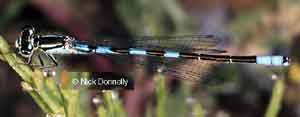
Image by Nick Donnelly Only one SW species |
GENUS: Eurasian Bluets Coenagrion one SW species
sizes: small, length 27 - 31 mm
|
| Photos
male - AZ male - CA female - CA pair - CA multiple images - CA pair - NM pair - NM male - UT male - UT male - UT male Scans pair - CA female - CA males - CO male - OR pair - OR |
Taiga Bluet Coenagrion resolutum
size: small, length 27 - 31 mm male: mostly black above inc. segs 6&7: pale blue to turquoise markings; U-shaped mark atop seg.2; green tinged thorax; top pale stripe can be interrupted; tear-shaped eyespots middle abdomen segments mostly black, black markings on segment 2 are U-shaped female: turquoise, tan, or green; very large eyespots habitat: slow waters in northern mountains; prefers still, shaded water SW flight period: May 22 - August 31 SW distribution: AZ, CA, CO, UT, *NM [*new 7-2008] Southwestern distribution map Information on California Odonata website |

Photo by Kathy Biggs Dancers are arranged by similarity in color and by markings. |
GENUS: Argia The Dancers - 30 SW species
sizes: medium, lengths 23 - 50 mm
|
| Photos
males - AZ male - AZ male - AZ male - AZ pair - AZ multiple images - AZ multiple images - CA female - CA male - CO male - NM male - NM male - NM male - NV male - NV male - NV male - NV male - NV pair - NV multiple images Scans male - AZ male - CA |
Aztec Dancer Argia nahuana
size: small/medium, length 23 - 37 mm male: brilliant sky-blue; thorax shoulder stripe variably forked (lower stripe can be interrupted); usually a spot, rather than a dash, on S2, S3-6 have a complete ring with tiny blue patches at lower-rear of S3,4,5 within the black bands S8-10 have a thin black line along bottom; distance between lower appendages from above less than width of individual appendages; inward pointing lope on appendages when viewed from above;some brown veins in the wings female: less colorful, thicker bodied than male; one form like male; other is tan and black similar species: VERY similar to California Dancer: use appendages to differentiate California Dancer usually has a stripe on segment 2 while the Aztec has a spot; wing vein color can be useful habitat: open rivers and streams SW flight period: February 4 - December 26 SW distribution: all SW Southwestern distribution map Information on California Odonata website |
| Photos
male - AZ multiple images - AZ female - AZ male - CA male - CA male - CA male - CA male, close-up thorax - CA male, in hand - CA multiple images - CA multiple images - CA multiple images - CA male - NV male - NV Scans male - CA male - CA male - CA male - CA male - CA pair - CA |
California Dancer Argia agrioides
size: small/medium, length 23 - 37 mm male: brilliant sky-blue; thorax shoulder stripe variably forked (lower stripe can be only interrupted); blue "tail" segments 8-10; distance between lower appendages from above greater than width of individual appendages no inward pointing lobe on appendages when viewed from above 2nd segment with a stripe on side female: less colorful, thicker bodied than male; one form like male; other is tan and black similar species: VERY similar to Aztec Dancer: use appendages to differentiate California Dancer usually has a stripe on segment 2 while the Aztec has a spot; wing vein color can be useful habitat: open rivers and streams SW flight period: February 2 - January 17 SW distribution: AZ, CA, NV, UT Southwestern distribution map Information on California Odonata website |
| Photos
multiple images - TX multiple images - TX, MX female Scans male female |
Leonora's Dancer Argia leonorae
size: small/medium, length 28 - 32 mm male: similar to CA and the larger Aztec Dancer; brilliant sky-blue; thorax shoulder stripe variably forked; clear wings; abdomen largely blue with each segment showing more black until blue "tail" segments 8- 10; lines strongly diagonal on abdomen sides; make ID using hand lens by viewing appendages female: less colorful, thicker bodied than male; one form like male; other is tan and black habitat: clear rocky streams in desert or even muddy -banked rivulets SW flight period: May 27 - October 23 SW distribution: NM UT (rare) Southwestern distribution map |
| Photos
multiple images - AZ male - CA male - CA male - CA male with mites - CA male, frontal close-up - CA female - CA female - CA female - CA male & female - CA multiple images - CA multiple images - CA male - NV male - NV male - NV male - NV female - NV pair (male colored female) - NV tandem pair - NV multiple images male - UT multiple images female - UT Scans male - CA male - CA male - CA female - CA scan odd pair - CA |
Vivid Dancer Argia vivida
size: medium, length 29 - 41 mm male: vivid blue & black markings; thorax top stripe has wide urn shape; side thoracic stripe pinched at mid-length; middle abdomen segment sides have small triangular black streaks; blue tip surrounds segments 8-10; when cool coloring becomes more violet; immatures - milky gray female: tan/gray & black or male-like habitat: seeps, streams; wanders SW flight period: capable of flight whenever there is a prolonged warm spell SW distribution: all Southwest Southwestern distribution map Information on California Odonata website |
| Photos
male - AZ male - AZ male - AZ male - AZ male - AZ male - AZ male - AZ male - AZ male - AZ male - AZ multiple images - AZ multiple images - AZ male - AZ male - AZ male - AZ teneral male - AZ multiple images - AZ multiple images - AZ pair- AZ male-colored female - AZ male - CO Scans male - AZ male - AZ |
Springwater Dancer Argia funebris - formerly A. plana
size: medium, length 33 - 40 mm male: like Vivid Dancer but more violet (AZ, western NM) or blue (eastern NM); differentiate from Vivid & also similar Apache Dancer by slightly wider, more rounded upper appendages (visible under hand lens); see p.114 Com. Drag. of SW; Rare forked side stripe form occurs female: like male or pale browns similar species: Spine-tipped Dancer (Argia extranea) habitat: canopied streams, seeps SW flight period: March 3 - January 25 SW distribution: AZ, CO, NM, UT Southwestern distribution map |
| Photos
female - NM male - TX female - TX pairs- TX multiple images - TX & MX male - TX Scans male female |
Comanche Dancer Argia barretti NEW FOR SW 2015
male: large blue dancer with unforked humeral stripe; black-bottomed abdominal segments 3-6 are topped with blue, long, backwards pointing 'spear points'; spot on side of Seg.2 often looks somewhat like a sideways "r"; black stripe atop thorax fairly narrow, and side stripe not split nor greatly pinched; large angular eyespots; looks somewhat like a Bluet: female: like no other large Dancer; often oviposit at least partially underwater while in tandem with the male similar species: Springwater Dancer (Argia plana) has more pinched thoracic side stripe, smaller mark on side of Seg2. and no black on sides of Seg9-10 habitat: rocky streams behavior: tandem oviposit in vegetation in riffles SW flight period: October 17 (in TX flies May-Nov.) SW distribution: Curry County, NM - rare, report all sightings Southwestern distribution map |
| Photos
male - AZ multiple images & info - AZ pair - AZ multiple images - MX multiple images - MX multiple images - MX Scans male female |
Yaqui Dancer Argia carlcooki NEW FOR USA 1998
size: medium, length 29- 32 mm male: blue-dolored wiht thickly-forked side thoractic spripe, S3-6 have long dark trianlge along ths side.S8-10blue on top and sides with black underneatah, S7 all dark. See Paulson, Dragonflies and Damselflies of the West p. 157-8 or photos and description at Jalisco Odonata. female: like male or pale browns habitat: slow streams, seeps SW flight period: August 8 - September 8 SW distribution: AZ Southwestern distribution map |
| Photos
male - AZ male - AZ males - AZ male - AZ male - AZ male - AZ male - AZ pair - AZ female - AZ multiple images - AZ male - AZ multiple images - AZ female - AZ male - MX male - MX pair - MX male & female- Jalisco, MX Scans male - female |
Spine-tipped Dancer Argia extranea
size: medium, length 32 - 37 mm male: bluish species; large eyespots; dark shoulder stripe has a downward projecting block near the front; black longitudinal stripe low on sides of blue "tail" segments 8-10; make ID using hand lens by viewing appendages &/or looking at side of segment 2 where there is a black 'saddle-shaped' mark See image at AZ Odes female: marked like male but less colorful similar species: Springwater and Apache Dancer habitat: small to medium rocky &/or sandy streams, usually with a lot of emergent vegetation SW flight period: March 15 - December 3 SW distribution: AZ, (rare) NM Southwestern distribution map |
| Photos
multiple images - AZ multiple images - TX male and female - Jalisco, MX Scans male female |
Apache Dancer Argia munda
size: medium, length 36 - 40 mm male: thin top and side black stripes; conspicuous pale line on low on side of thorax; wider, more rounded upper appendages (visible under hand lens) than Vivid Dancer; see p.114 Co. Drag. of SW similar species: Spine-tipped, Vivid and Springwater Dancers female: like male or pale browns habitat: canyon streams, even intermittent SW flight period: April 27 - October 28 SW distribution: AZ, NM, NV, UT Southwestern distribution map |
| Photos
male - AZ multiple images - AZ multiple images - AZ male & females - Jalisco, MX Scans male - female - |
Tarascan Dancer Argia tarascana
size: medium, length 33 - 39 mm male: blue and black species with wide, split side stripe, top split forms a backwards pointing arrow; large eyespots; abdominal segments 8-10 blue; differentiate by appendages using hand lens - see p.180 Paulson's Dragonflies & Damselflies of the West female: like male or pale browns habitat: streams, ditches SW flight period: May 11 - November 27 SW distribution: AZ Southwestern distribution map |
| Photos
male - AZ male - AZ male - AZ male - AZ multiple images - AZ female male and female - Jalisco, MX Scans male - female - |
Sabino Dancer Argia sabino
size: medium, length 33 - 39 mm male: similar to Tarascan Dancer blue, violet and black; split side stripe; large eyespots; abdominal segments 8-10 blue; differentiate by appendages using hand lens - see p.181 Paulson's Dragonflies & Damselflies of the West female: like male or pale browns habitat: streams with large boulders SW flight period: May 16 - October 14 SW distribution: AZ - Sabino & Sycamore Canyons Southwestern distribution map |
| Photos
male - AZ male - AZ multiple images - AZ multiple images - AZ pair - AZ Scans male female |
Pima Dancer Argia pima
size: medium, length 35 - 43 mm male: similar to Sierra Madre Dancer; split side stripe; blue, violet and black species; clear wings with black venation; large eyespots; abdominal segment 1 pale with dark triangular mark on top; differentiate by appendages using hand lens - see p.181 Paulson's Dragonflies & Damselflies of the West female: like male or tan with more black than male habitat: small streams, often rocky, in wooded areas SW flight period: July 15 - October 30 SW distribution: AZ Southwestern distribution map |
| Photos
male - AZ male - AZ male - AZ male - AZ male - AZ male - AZ male - AZ male - AZ males - AZ males - AZ multiple images - AZ multiple images - AZ multiple images - AZ pair - AZ pair - AZ pair - AZ male - NM male & female- Jalisco, MX Scans male - female - | Sierra Madre Dancer Argia lacrimans
size: medium, length 37 - 46 mm male: blue and black species with clear wings; large eyespots; abdominal segments 8-10 blue; similar to Pima Dancer; differentiate by appendages using hand lens; and Sierra Madre Dancer female: like male or pale browns; segments 8 & 9 blue habitat: small rocky steams in wooded areas SW flight period: May 27 - November 1 SW distribution: AZ Southwestern distribution map |
| Photos
male - AZ male - AZ multiple images - AZ male - AZ male - AZ male - AZ male - AZ multiple images - AZ & MX appendages male - MX male - MX males - MX male & female, Jalisco, MX Scans male & female |
Cerulean Dancer Argia anceps NEW SPECIES FOR USA - MARCH 2013
size: medium, length 37 - 41 mm male: bright blue and black species with amber-tinted wings; large eyespots; All the abdominal segments are blue on the top; side stripe pinched but not forked; seg 2 has short dark stripe on the side, somewhat wider at the end. similar to Sierra Madre Dancer; differentiate by appendages using hand lens female: like male or pale browns; segments 8 & 9 blue similar species: comparison with very similar Sierra Madre Dancer Argia lacrimans habitat: small rocky steams SW flight period: March 28 - November 15 SW distribution: AZ (rare) Southwestern distribution map |
| Photos
multiple images - AZ | Marsh Dancer Argia paludicola
size: ~ 22 mm male: blue and black patterned; side stripe forked and wide, whole abdomen top blue; wings clear female: more brown with white on side of thorax more noticeable habitat: marches SW flight period: June 4 - July 16 SW distribution: southeastern AZ, very rare Southwestern distribution map |
| Photos
male - AZ multiple images - AZ/MX male - AZ image - AZ/MX male & female - Jalisco, MX Scans male - MX |
Harkness's Dancer Argia harknessi
size: 33 - 40 mm male: blue and black patterned; side stripe pinched, not split female: like male or browner habitat: large rivers, with or without strong currents, cutting through thorn-scrub and thorn-forest. SW flight period: June 5 - October 29 SW distribution: southeastern AZ, very rare Southwestern distribution map |
| Photos
male - CA male - CA male - CA male - CA multiple images - CA multiple images - CA pair - CA female, close-up of thorax - CA male - CO male & female - CO pair - CO pair - CO pair in cop - CO male - NV multiple images female - UT Scans male side - CA male top - CA male - CA pair - CA female - CA female - CA |
Emma's Dancer Argia emma
size: medium, length 32 - 40 mm male: purplish species; occurs further north than Tonto; thoracic side stripe pinched at middle; black stripe top of thorax unique - very narrow & straight; abdomen lavender and black with no side triangles, short black vertical stripes sides of segments 8 & 9; pale stigma; see appendage chart below (p.114) female: male-like or yellowish tan; top thoracic stripe very thin habitat: rocky streams, rivers SW flight period: March 10 - October 11 SW distribution: CA, CO, NV, UT Southwestern distribution map Information on California Odonata website |
| Photos
male - AZ male - AZ male - AZ male - AZ male - AZ male - AZ male - AZ multiple images - AZ multiple images - AZ multiple images - AZ multiple images - AZ pair - AZ pair - AZ female - AZ female - AZ female, close-up thorax - AZ male - NM male - NM male - NM male - NM male - NM Scans male female - AZ |
Tonto Dancer Argia tonto
size: medium, length 39 - 44 mm male: violet or purple species; narrow top thoracic stripe; large eyespots; back of head pale; dark shoulder stripe pinched, not forked, lower end abruptly wider than upper end; abdomen with no dark side streaks on sides; tail-tip violet; range is south of Emma's Dancer's; appendages p. 114 female: like male, color usually tan; top stripe a bit wider similar species: Tezpi Dancer ( Argia tezpi), Sooty Dancer (Argia lugens), and Dusky Dancer (Argia translata) habitat: wooded mountain streams SW flight period: May 14 - December 30 SW distribution: AZ, southwestern NM Southwestern distribution map |
| Photos
male - AZ male - AZ multiple images - AZ male - CO male - CO male - CO male - CO male - NM pair - NM male - NM male - NM male - NM multiple images- MX male female female Scans male - SD male - LA |
Variable Dancer Argia fumipennis violacea
size: medium, length 29 - 34 mm male: violet when mature; thoracic shoulder stripe forked; top stripe wide & straight; lower half of thorax without contrasting white; "tail" is violet with black under 8-10; in SW slightly smoky wings; prefers slow moving areas of streams female: like male but light brown or tan with wide black stripe on abdomen side similar species: Lavender Dancer: abdominal segment 8 is blue, thus does not contrast in color with segment 9. Segments 8 and 9 have short, rather thin lateral black stripes habitat: slow streams, ponds SW flight period: April 2 - November 20 SW distribution: AZ, CO, NM Southwestern distribution map |
| Photos
male - AZ male - AZ male - AZ male - AZ male - AZ immature male - AZ pair - AZ pair - AZ multiple images - AZ multiple images - AZ multiple images - AZ female - AZ pair - AZ pair - CA multiple images - CA male - CA male - CA male - NM male - NM multiple images - NM Scans male female |
Lavender Dancer Argia hinei
size: small/medium length 30 - 35 mm male: violet when mature; thoracic shoulder stripe forked; frontal stripe wide; mature males show lower half of thorax pruinose white; segment 8-10 form contrasting blue "tail" with black under 8 & 9 only; prefers shallow rocky stream areas female: light brown; abdomen & thorax patterning similar to male; dark intrusions on pale tail tip similar species: Emma's Dancer's side stipe not forked; Variable Dancer segment 8 is violet habitat: streams (even ephemeral) SW flight period: January 28 - December 28 SW distribution: all southwestern states Southwestern distribution map Information on California Odonata website |
| Photos
male - AZ male - AZ close-up of thorax - AZ male - AZ male - AZ males - AZ multiple images - AZ multiple images - AZ multiple images - AZ multiple images - AZ female - AZ male - NM male - NM female - NM Scans male - male - AZ female - |
Amethyst Dancer Argia pallens
size: medium, length 32 - 35 mm male: almost all violet & very pale, even eyes, legs & tops of segs 8-10; top thoracic stripe thin & narrow, dark side stripe very thin and pinched at middle; prothorax ("neck") violet; pale stigma; no triangles down side of abdomen; segment 7 pale, not black female: like male or brown where male is violet habitat: small streams SW flight period: January 19 - December 17 SW distribution: AZ, NM Southwestern distribution map |
| Photos
male - AZ male - AZ young male - AZ young male - AZ multiple images - AZ pair - AZ multiple images - AZ multiple images - AZ pairs - AZ male - NM pairs - MX multiple images- MX male female female male & female - Jalisso, MX Scans male - TX female - |
Dusky Dancer Argia translata
size: medium, length 32 - 38 mm male: dark gunmetal blue coloration; dark side stripe can disappear with age; abdomen very thin and dark with 4 narrow pale rings; no blue "tail"; top of eyes purple; wings clear or slightly smoky; lower thorax becomes dark pruinose; black legs female: like male or tan; segments 8-10 pale side stripe similar species: Tonto Dancer (Argia tonto), Sooty Dancer (Argia lugens) and Tezpi Dancer (Argia tezpi) are similar: comparison images/info habitat: open streams, rivers SW flight period: March 4 - January 17 SW distribution: AZ, NM Southwestern distribution map |
| Photos
pair - IL multiple images male - AL Scans male - LA female - LA female - LA female - LA female - LA |
Blue-tipped Dancer Argia tibialis
size: medium, length 30 - 38 mm male: dark and boldly marked body; lacking noticable eyespots; thorax dark violet top, with white on sides; abdomen black with very narrow pale rings, blue ONLY on segs 9 &10 female: two forms: one is brown, other shows bright blue on thorax and face; thorax with split side stripe habitat: small wooded sandy streams SW flight period: June 25, 2010 SW distribution: CO (rare, please report all sightings) Southwestern distribution map |
| Photos
male - AZ male - AZ male - AZ male - AZ multiple images - AZ multiple images - AZ/MN male - NM male - NM male - NV male - NV male - NV male - NV male - NV female - NV female - NV pair - NV Scans male - female - TX |
Kiowa Dancer Argia immunda
size: small/medium, length 26 - 38 mm male: blue or blue violet & black; pale thoracic side stripe wide and irregular in shape; dark side stripe forked; large eyespots; abdominal segments 3-6 unique with thin pale basal ring & then 3 alternating black-pale- black markings each of approximately the same width; wings clear, dark veins female: tan where male is blue habitat: streams & rivers, lakes SW flight period: year-round in appropriate weather SW distribution: AZ, CA (historic), CO, NM, NV Southwestern distribution map Information on California Odonata website |
| Photos
male - AZ male - AZ multiple images - AZ multiple images - CA males - CA male - CA (new early flight data) male - CO male - CO male - CO male - CO male - CO male - CO male - CO female - NM female - NM male - NV male - NV male - NV female - NV Scans male - CA male - CA male - CA male - CA male - CA immature male - CA male appendages - CA female - CA female - NV |
Paiute Dancer Argia alberta
size: small/medium, length 26 - 32 mm male: small, dark for a dancer; dark thoracic shoulder stripe prominent and forked; small eye-spots; wings clear, dark veins; abdomen mostly dark with contrasting blue or grayish purple rings that don't close at the top, middle segments black on top; immatures colored more violet female: blue or light brown, both with noticable black pointed stripes near top side of abdomen SW flight period: February 21 - December 15 SW distribution: all Southwest Southwestern distribution map Information on California Odonata website |
| Photos
male - AZ multiple images - AZ male - NM female - NM male & female- Jalisco, MX Scans male female |
Tezpi Dancer Argia tezpi
size: medium, length 34 - 42 mm male: even darker than Dusky Dancer; head dark except for pale eyespots; thorax with somewhat metallic violet top stripe; wings golden; segments 1-7 black above, sometimes with greenish reflections, 3-7 have incomplete rings, 8-10 variable female: like male similar species: Tonto Dancer ( Argia tonto), Sooty Dancer (Argia lugens), Dusky Dancer (Argia translata) habitat: streams SW flight period: March 4 - January 17 SW distribution: AZ, NM Southwestern distribution map |
| Photos
male - AZ male - AZ male - AZ male - AZ male - AZ male - AZ multiple images - AZ multiple images - AZ multiple images - AZ female (blue) - AZ male - CA multiple images - CA multiple images - CA female - CA female - CA male-colored female - CA male - CO male - CO male - CO male - NM male - NM male - NM male - NM male - NM pair - NM male - NV Scans male - CA young male - CA female (brown) - CA female (blue) - CA |
Sooty Dancer Argia lugens
size: medium large, length 40 - 50 mm male: large for a damselfly; unlike most Dancers, no blue near abdomen tip; thorax develops dark sooty blue pruinosity; noticeable pale ring around each segment; dark eyes; dark wing veins can become slightly smoky; perches on rocks; immature patterned brown like female female: thorax patterned blue or brown; pale rings abdomen similar species: compare to Tonto Dancer (Argia tonto), Dusky Dancer (Argia translata) and Tezpi Dancer (Argia tezpi) habitat: rocky streams, rivers SW flight period: February 3 - December 27S SW distribution: all SW except northern NV, UT, CO Southwestern distribution map Information on California Odonata website |
| Photos
male - AZ male - AZ males - AZ young male - AZ multiple images - AZ multiple images - AZ multiple images - AZ female - AZ female - AZ multiple images - CA multiple images - CA multiple images - CA male - CO male - CO male - NM male - NM male - NM male - NM female - NM female - NM male - NV young male - NV female - NV pair - NV female & male - UT female - UT Scans pair - CA female - CA |
Powdered Dancer Argia moesta
size: medium, length 37 - 43 mm male: large for a damselfly; develops chalky/powdery white/gray pruinosity with age, especially thorax; abdomen turns pale gray on segments 8- 10; compare immature males and females with Blue-fronted Dancer female: pale blue or light brown thorax; older females sometimes become a bit pruinose habitat: rocky rivers, windy lakes SW flight period: February 3 - December 27 SW distribution: all SW states Southwestern distribution map Information on California Odonata website |
| Photos
multiple images - AZ female, close-up thorax - AZ male Scans male - TX male - TX male - TX male - TX female - TX female - TX female - TX |
Blue-fronted Dancer Argia apicalis
size: medium, length 33 - 40 mm male: bright blue thorax, top and shoulder stripes very thin; blue face; clear wings; black abdomen, segments 8-10 blue; small brown stigma; dark eyes, tiny eyespots; compare to similar immature Powdered Dancer female: same markings; can be colored male-like or rusty brown habitat: muddy rivers & lakes SW flight period: March 12 - October 23 SW distribution: AZ, CO, NM Southwestern distribution map |
| Photos
male - AZ male - AZ male - AZ multiple images - AZ multiple images - AZ multiple images - AZ males & females - CA multiple images - CA female - CA male - NM male - NM male - NM male - NM male - NM male - NM male - NV male - NV male - NV male - NV male - NV male - NV male - NV male - NV female - NV female - NV female - NV tandem pair - NV Scans male - AZ male - CA male - CA female - CA female - CA |
Blue-ringed Dancer Argia sedula
size: medium, length 29 - 34 mm male: black abdomen has narrow blue rings separating sections; blue "tail" 8-10 on top side only; thorax has wide dark side and top stripe; wings dark veined, amber tinged female: always paler than male, showing olive-tan wherever male is blue; wings amber-tinged habitat: sunny sections of small/medium rivers SW flight period: January 18 - December 31 SW distribution: all Southwest Southwestern distribution map Information on California Odonata website |
| Photos
multiple images - AZ male - AZ male - AZ multiple images - Jalisco, MX |
Oculate Dancer Argia oculata
size: small/medium, 31-41 mm male: abdomen mostly dark with backwards pointing blue arrows atop the segments nearest the thorax; side thoracic stripe wide and forked; "tail" black on underside with blue on top of S8-10 female: thorax like male, but abdomen with rings, not points; blue and tan forms exist habitat: ponds; slow moving water SW flight period: August 8 - October 3 SW distribution: southern AZ Southwestern distribution map |
| Photos
male - AZ male - AZ male - AZ pair - AZ female - AZ female - AZ multiple images - AZ multiple images - AZ multiple images - AZ male - NM male - NM male - NM pair - NM pair - NM female - NM male & female - Jalisco, Mx Scans male - AZ female |
Fiery-eyed Dancer Argia oenea
size: medium, length 33 - 39 mm male: upper eyes bright red, blue wash back of the eye; coppery orange face; top of thorax dark metallic coppery red; abdomen segments 3-6 violet (or blue) above with blue (or violet) "tail" segments 8-10; dark legs; clear wings female: like male or brown; no red; pale "island" in midst of dark side stripe habitat: streams and rivers SW flight period: March 29 - December 18 SW distribution: AZ, NM Southwestern distribution map |
| Sketches
Dancer appendage sketches by Rosser Garrison |
Dancer appendages Argia male appendages
sometimes it is necessary to have a Dancer in hand and examine its terminal appendages using a 10X+ hand lens to make a final identification. Dorsal and lateral views |
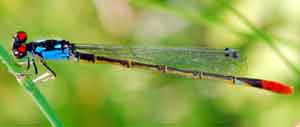
Image by Troy Hibbitts Only one SW species |
GENUS: Painted Damsel Hesperagrion one SW species
sizes: medium, length 27 - 35 mm
|
| Photos
male - AZ male - AZ male - AZ male - AZ male - AZ male - AZ male - AZ male - AZ male - AZ male - AZ male - AZ male - AZ male - AZ males - AZ immature male - AZ multiple images - AZ teneral - AZ female - AZ young female - AZ multiple images - AZ pair in cop - AZ male - NM male - NM male - NM male - NM female - NM female - NM Scans male - NM young female - NM |
Painted Damsel
Hesperagrion heterodoxum
size: medium, length 27 - 35 mm male: red eye spots; red top segments 8-10; yellow under segments 1-7; 4 blue marks thorax top, sides blue, yellow brown in immature; like no other Southwestern damselfly; coloration variable by age - immature all orange female: blue tail only top segment 7; thorax top -blue triangles; similar to Plain's & Pacific Forktails habitat: creeks and streams SW flight period: all year in its southern reaches SW distribution: AZ, NM Southwestern distribution map |
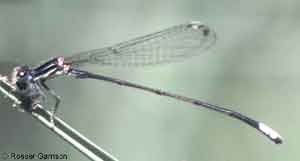
Image by Rosser Garrison Only one SW species |
GENUS: Black and White Damsel Apanisagrion ONLY one species
sizes: medium; 32-37 mm
|
| Photos
male - AZ male - AZ male - AZ immature male - AZ female - AZ female - AZ female - AZ multiple images - AZ multiple imges - AZ multiple images - AZ male & female - Jalisco, MX Scans male female |
Black-and-White Damsel Apanisagrion lais
size: medium, length 32 - 37 mm (needs further determination) male: immatures largely orange and similar in appearance to a Firetail or immature female Forktail; matures become very dark with yellow-green marking; segments 1-7 greenish to tan underside and almost entirely black or dark brown; segments 8-10 all dark but may become pruinose on top, especially on 8 & 9; unique dense venation on lower margins of wings female: very similar to male habitat: slow streams in woodland with grasses &/or watercress SW flight period: April 6 - November 20 SW distribution: AZ,(rare) NM Southwestern distribution map |
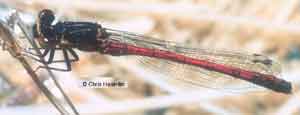
Image by Chris Heaivilin Only one SW species |
GENUS: Red Damsels Amphiagrion one SW species
sizes: very small; 23-28 mm
|
| Photos
multiple images - AZ multiple images - AZ male - CA male - CA female - CA female - CA pair in wheel - CA pair in wheel - CA multiple images - CA male - CO male - CO male - CO male - CO male - CO male - CO female - CO female - CO male - NM male - NM pair - NV multiple images male - UT Scans male - CA male - CA female - CA pair - CA male - OR |
Western Red Damsel Amphiagrion abbreviatum
size: very small, length 23 - 28 mm male: stocky; hairy black head and thorax, brown eyes, black on top; bright red abdomen barely extends beyond wings; black top and/or sides segments 7-10; dark legs female: stout; pale peach to reddish; thorax tawny; rare dark pruinose form exists habitat: mountain lakes, marshes, slow streams SW flight period: April 12 - October 24 SW distribution: all Southwest Southwestern distribution map Information on California Odonata website |
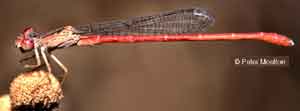
Image by Pete Moulton Only one SW species |
GENUS: Firetails Telebasis one SW species
sizes: very small; 23-29 mm
|
| Photos
male - AZ male - AZ male - AZ male - AZ male - AZ multiple images - AZ multiple images - AZ female - AZ female - AZ female - AZ pair - AZ pair - AZ pair - AZ pair - AZ pair - AZ multiple images - AZ multiple images - AZ multiple images - CA male - CA pair - CA pair - CA multiple images - CA pair - NM male - NV Scans male - CA male - CA males - CA |
Desert Firetail Telebasis salva
size: very small, length 23 - 29 mm male: dainty and slender; all red abdomen extends well beyond wing tips; red face and eyes; black eye spots; thorax red with black; red legs; tip of abdomen without black female: some black thorax top; eggs laid in algae mats habitat: shallow waters with algae scum; lowlands (not just in deserts) SW flight period: March 19 - January 9 SW distribution: all SW, except CO Southwestern distribution map Information on California Odonata website |
Photos

Image by Roy Beckemeyer Only one SW species NEW 9/2016 |
GENUS: Slender Threadtails Protoneura
This subtropical genus is known from only a few sightings in Arizona. sizes: medium; 34-37 mm
|
| Photos
multiple images - AZ & MX multiple male images - AZ multiple male images - AZ male in flight - AZ tandem pair - AZ ovipositing pair - AZ ovipositing pair -AZ female - AZ male & multiple ovipositing pairs - Jalisco, MX Scans |
Orange-striped Threadtail Protoneura cara
sizes: medium; 34-37 mm
|
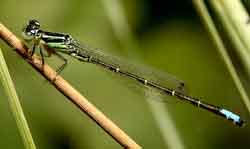
Photo by Ray Bruun Forktails are arranged by similarity in markings. nymph appendages comparison another appendages chart |
GENUS: Forktails - Ischnura - 11 SW species ...pages 120-128
sizes: small, lengths 20 - 35 mm
|
| Photos
male - AZ male - AZ female - AZ female - AZ female - AZ multiple images - AZ multiple images - AZ males & females - AZ & CA male - CA males - CA female - CA multiple images - CA dispersal/migratory event - CA male - NM male - NV female - NV male-colored female eating - NV female, male colored - NV pair - NV Scans male - AZ male - CA male-colored female - CA |
Rambur's Forktail Ischnura ramburii
size: medium, length 27 - 36 mm male: green-blue shoulder stripe very thin, parallel sided; tiny circular eyespots; thorax and segments 1-3 greenish-blue; yellowish-orange underside only of segments 3-7; blue surrounds segment 8, part of 9, not top of 10; lower appendages point straight out female: male-like or Day-Glo red/orange turning tan/olive; wide black stripe thorax top similar species: Desert Forktail has thicker stripes atop thorax and teardrop-shaped eyespots: comparison Rambur's & Desert males; use appendages chart comparison images/info comparative scan Rambur's/Desert comparative scan Rambur's/Desert habitat: pond/lake/slow streams SW flight period: all year in the south SW distribution: AZ, CA, NM, NV Southwestern distribution map Information on California Odonata website |
| Photos
male - AZ multiple images - AZ pair - AZ female - AZ male - CA male - CA male - CA male - CA males & females- CA multiple images - CA male - NM male - NM pair - NM pair - NM male - NV male - NV male - NV male-colored female - NV male-colored females ovipositing - NV pair - NV multiple images male - UT multiple images female - UT Scans pair - AZ male - CA male - CA male - CA male - CA male - CA male - CA male - CA male - CA male & female - CA pair - CA |
Desert Forktail Ischnura barberi
size: medium, length 27 - 35 mm male: pale shoulder stripe thicker than Rambur's, widest near eyes; large tear-shaped eyespots connected by a line; pale orange on mid segments curves partly up & over the abdomen leaving the dark areas on top appearing dart shaped; blue surrounds all of segments 8 & 9; lower appendages point upward female: like male or pale tan-orange; narrow top stripe similar species: Rambur's Forktail has thinner stripes atop thorax and circular eyespots: comparison Rambur's & Desert males; use appendages chart comparison images/info comparative scan Rambur's/Desert comparative scan Rambur's/Desert habitat: pond/lakes/slow streams SW flight period: capable of flight in any appropriate weather SW distribution: all Southwestern states (rare CO) Southwestern distribution map Information on California Odonata website |
| Photos
male - AZ male - AZ male - AZ multiple images - AZ multiple images - AZ mature female - AZ multiple images - CA male - CA female - CA young female - CA pair in wheel - CA male - CO male - CO male - NM male - NM mature female - NM Scans male - CA female - CA |
Citrine Forktail Ischnura hastata
size: very small, length 20 - 27 mm (smallest Ode in North America) male: abdomen (even tip) mostly yellow above & below with some black; thoracic stripes green; forewing - pale reddish-brown stigma that is NOT touching the leading edge; hind wing has (usual) dark stigma; noticable fork atop seg. 10; use appendages chart female: immature orange & black with segments 1-4 mostly orange; mature - pale pruinose with black stripe atop thorax similar species: the mature pruinose female is similar to the pruinose Western & Mexican Forktails; the immature female is similar to the immature female Mexican & Wesertn Forktails; see comparison images/info habitat: marshes/ponds/streams SW flight period: all year in the south SW distribution: AZ, CA, CO, NM, NV Southwestern distribution map Information on California Odonata website |
| Photos
male - PA & NY female - NM female - NM Scans male female - Hawaii |
Fragile Forktail Ischnura posita
size: very small, length 21 - 29 mm male: matures are mostly dark with some yellow-green with exclamation marks atop thorax and no blue 'tail' female: matures are mostly dark with blue exclamation marks atop thorax; lack vulvar spine on segment 8 and have subtriangular mesostigmal plates with raised lateral corners. similar species: the Exclamation Damsel is larger and only occurs in California habitat: Heavily vegetated ponds, marshes and slow moving waters SW flight period: April - early June SW distribution: CO, NM - new to both in 2018 Southwestern distribution map |
| Photos
male - CA male - CA male - CA male - CA mature female - CA mature female - CA male-colored female - CA immature female - CA immature female - CA multiple images - CA multiple images - CA male - NV mature female - NV immature female - UT Scans male - CA male - CA male - CA male - CA male - CA female - CA female - CA immature female - CA |
Western Forktail Ischnura perparva
size: small, length 21 - 33 mm male: thorax sides & top - blue-green stripes; noticeable fine pale rings across each dark abdomen segment; blue tip has dark intrusions on sides; use appendages chart female: immature orange & black with segments 1-3 mostly orange; becomes pale pruinose at maturity habitat: weedy ponds, creeks behavior: females solo oviposit; only mate once, then curl their 'tail' down to signal to approaching males that they are not interested in sex! SW flight period: March 1 - November 13 SW distribution: all Southwestern states Southwestern distribution map Information on California Odonata website |
| Photos
male - AZ male - AZ male - AZ multiple images - AZ female - AZ immature female - AZ mature female - AZ mature female - AZ mature female - AZ mature female - AZ multiple images - AZ multiple SW images male - NM male - NM male - NM male - NM male - NM mature female - NM immature female - NM Scans male - AZ female - AZ |
Mexican Forktail Ischnura demorsa
size: small, length 21 - 33 mm male: thorax sides & top - blue-green stripes; noticeable fine pale rings across each dark abdomen segment; blue tip has dark intrusions on sides; dual 'forks' atop seg. 10 - pale tipped female: immature orange & black with segments 1-3 mostly orange; becomes pale pruinose similar species: both Eastern and Western Forktail males are similar; use appendages chart female is similar to Eastern, Western and Citrine Forktails habitat: weedy ponds, creeks SW flight period: February 2 - December 23 SW distribution: AZ, CO, NM, NV, UT Southwestern distribution map |
| Photos
male - CO male - CO immature female - CO male-colored female - CO male - NE male male male info - north east multiple images - MN male - WI mature female immature female Scans male & female - SD |
Eastern Forktail Ischnura verticalis
size: small, length 21 - 33 mm male: thorax sides & top - blue-green stripes; noticeable fine pale rings across each dark abdomen segment; blue tip has dark intrusions differentiate from Western and Mexican by appendages - use appendages chart female: immature orange & black with segments 1-3 mostly orange; becomes pale pruinose habitat: weedy ponds, creeks SW flight period: May 2 - October 20 SW distribution: CO, NM Southwestern distribution map |
| Photos
male - AZ male - AZ male - AZ male - AZ multiple images - AZ male - CA male - CA male - CA pair - CA pair - CA immature female - CA immature female - CA male-colored female - CA mature female - CA multiple images - CA multiple images - CA male - NV mature female - NV multiple images - NV multiple images male - UT multiple images immature female - UT Scans male - CA male - CA female - CA male - CO |
Pacific Forktail Ischnura cervula
size: small, length 22 - 34 mm male: abdomen black with blue "tail" markings that touch top & bottom; black thorax top - 4 tiny blue spots, 1 each "corner"; thorax sides blue; upright 'fork' at top end of tail; use appendages chart female: stripes on top of thorax; shows pinkish-orange eyespot color as immature; becomes all dark pruinose when mature; pale stigma; long hairs extend from prothorax toward the midline in all ages/stages abdomen tip pattern - 2 narrow blue rings bracketing segment 8; male-like form has larger dots atop thorax than males do similiar species: Plains Forktail has less of a 'fork' atop segment 10; and the top of segment 2 has blue on the sides that wraps up around the rear of the black, from slightly to almost forming a blue ring habitat: weedy ponds & creeks SW flight period: all year in south SW distribution: all SW Southwestern distribution map Information on California Odonata website |
| Photos
multiple images - AZ multiple images - AZ female, immature - AZ male - CO male - CO male - CO male - CO male - CO male & female - CO immature female & female - CO pair - CO male - NM male - NM male - NM male - NM male - NM male - NM male - NM male - NM male - NM male & female- NM mature female - NM immature female - NM male - UT Scans males & females - SD |
Plains Forktail
Ischnura damula
size: small, length 22 - 34 mm male: abdomen black with blue "tail" markings that touch top & bottom; black thorax top - 4 tiny blue spots, 1 each "corner"; thorax sides blue; 'fork' top end of tail small; use appendages chart p.126 female: stripes top of thorax; shows pinkish-orange eyespot color as immature; becomes all dark pruinose when mature; 2 elevated projections on top of the prothorax; Pacific Forktails have long hairs extending back from the prothorax toward the midline, Plains Forktail lacks them; pale stigma; male-like form has larger dots similiar species: Pacific Forktail has a more extensive 'fork' atop segment 10; and the top of segment 2 is all black habitat: weedy ponds & creeks SW flight period: February 9 - October 29 SW distribution: AZ, CO, NM, UT Southwestern distribution map |
| Photos
male - AZ multiple images - AZ multiple images - AZ male - CA male - CA young male - CA multiple images - CA multiple images - CA female - CA male - CO male - NM male - NM male - NV female - NV male & female- Jalisco, MX Scans male - CA male - CA male - CA female - CA male & females - CA male & female - NV |
Black-fronted Forktail Ischnura denticollis
size: very small, length 22 - 26 mm male: no stripes or dots top of thorax; all dark above, sides of thorax blue (green in immature); blue patches on top & bottom segments 8-9 do not touch; chartreuse underside; stigma has white margin at rear; frail; top appendages bent down. SF Forktail, rare, CA's Bay Area, lower appendages not as hooked/noticeable similar species: the very rare San Francisco Forktail is the 'twin' to the Black Fronted, but has differently shaped appendages; lacks the white margin at the rear of the stigma: all 'Black-fronted' type forktails in the Bay Area that appear to not have this stigma should be examined in hand. The two species have been known to hybridize. female: immature - pale coral; mature green/blue thorax sides habitat: lakes, ponds, seeps SW flight period: January 4 - December 26 SW distribution: all Southwest Southwestern distribution map Information on California Odonata website |
| Photos
multiple images male - CA male - CA male - CA male - CA male - CA male - CA male - CA male - CA male - CA multiple images - CA multiple images - CA female - CA female - CA female - CA mature female - CA immature female - CA pair in tandem - CA pair in tandem - CA pair in wheel - CA pair in wheel - CA Scans male - CA male - CA male - CA male - CA female - CA pair - CA |
San Francisco Forktail
Ischnura gemina
size: small, length 24 - 28 mm; wingspan ~28 mm male: thorax top and abdomen dark; blue spots on segments 8 and 9; underside chartreuse; appendages up-pointing female: cryptic brown, reddish, or male-like similar species: very similar to Black-fronted Forktail, hence the Latin name `gemina' for twin; SF Forktail is slightly more robust; compare the two by appendages; SF Forktail lacks white margin at rear of stigma; eye spots back of head are more circular in shape than Western's, Mexican's, Eastern's or Pacific's SW habitat: weedy ditches; often near salt water SW flight period: March 8 - November 6 SW distribution: CA endemic; S.F. Bay Area; Santa Cruz (historical); rare: PLEASE REPORT ALL SIGHTINGS Southwestern distribution map Information on California Odonata website |
| Photos
male - CA male - CA male - CA male - CA male - CA male - CA female - CA female - CA female - CA female - CA female - CA female - CA pair - CA pair - CA multiple images - CA multiple images - CA Scans male - CA male - CA male - CA female - CA female - CA male & female - CA |
Swift Forktail Ischnura erratica
size: medium, 29 - 34 mm male: blue stripes on top of thorax with black in center; larger than most other forktails with bolder markings; yellow under abdomen with thin yellow rings; blue on thorax sides is similar in shape to blue on sides of Bluets; blue on sides has a dark line coming in from the back at mid-height; dark abdomen has blue spots top of segments # 8 - 9; lower appendages are much longer than uppers; long enough to see thru binoculars; stigma bi-colored female: abdomen top all dark, with dark green thorax sides, eye spots, and thoracic side stripes; or colored like male; similar species: larger than other similarly dark Forktail species; continuous blue side stripe, not the !! of the similarly sized Exclamation Damsel; Western Forktails are much smaller and have a much more prominent blue line between the post-ocular eye spots; use appendages to differentiate SW habitat: ponds and creeks SW flight period: February 24 - September 17 SW distribution CA Southwestern distribution map Information on California Odonata website |
| Sketches
forktail appendage sketches by Natalia von Ellenrieder |
Forktail Ischnura male appendages scan
Examine forktail appendages in hand using a hand lens and compare to these terminal appendage illustrations to make a final identification |
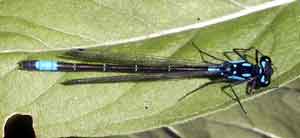
Image by Dave Biggs Only one species |
GENUS: Exclamation Damsel Zoniagrion ONLY one species
sizes: medium; length 30 - 35 mm
|
| Photos
multiple - CA male - CA male - CA male - CA male - CA male - CA male - CA male - CA male - CA male's appendages - CA female - CA female - CA female - CA female - CA female - CA brown form female - CA brown form female - CA brown form female - CA multiple images - CA multiple images - CA multiple images - CA multiple images - CA Scans male - CA male - CA male - CA female - CA |
Exclamation Damsel Zoniagrion exclamationis
size: medium; length 30 - 35 mm male: slender; blue & black; thorax top dark with a pair of turquoise !!; blue top of segments 1&2, 7-9 only female: similar but blue on end of abdomen is only on segments 7 and 8; !! marks on top of thorax may be merged; irregularly shaped eyespots, inner end points towards center & the outer end points forward similar species: larger than most similarly dark Forktail Ischnura species; Swift Forktail has continuous blue thoracic stripe, not !! - Use appendages to help differentiate behavior: often rests with wings held slightly open; eggs laid in leaf blades & stems habitat: permanent pools of mud-banked streams SW flight period: March 19 - September 8 SW distribution: CA endemic; northern coastal and central valley counties Southwestern distribution map Information on California Odonata website |

Image by Jim Johnson Only one SW species |
GENUS: Sprites Nehalennia one SW species
sizes: tiny; length 25 - 30 mm
|
| Photos
male - CA multiple images- CA male & female - MN male - OR female - OR multiple images - MN male Scans pair - CA pair - OR pair - OR male - WV female - WV |
Sedge Sprite Nehalennia irene
size: small, length 25 - 30 mm male: mostly dark with green; top of thorax and abdomen metallic green; middle segments at least 50% black from above; thorax top entirely metallic green, sides blue; abdomen blue in male, green for females; black areas whole length of abdomen; black spot rear of 2nd abdominal segment SW habitat: slow waters: sedge marshes/bogs/lakes/ponds/streams/rivers female: very similar to male SW flight period: June 13 - August 25 SW distribution: northern CA Southwestern distribution map Information on California Odonata website |
Click here to go to page 2 of the Southwestern Dameselflies (non-Pond Damsels) page
Click here to return to the opening page of Southwestern Dragonflies
I'm glad you enjoy the dragonflies and damselflies too! THANK-YOU for visiting!!
Kathy Biggs, Azalea Creek Publishing Email Kathy Biggs